pH balanced and free of harsh ingredients, this homemade baby wash and shampoo gently cleanses delicate skin. It has a sweet, gentle fragrance without synthetic perfumes or essential oils.
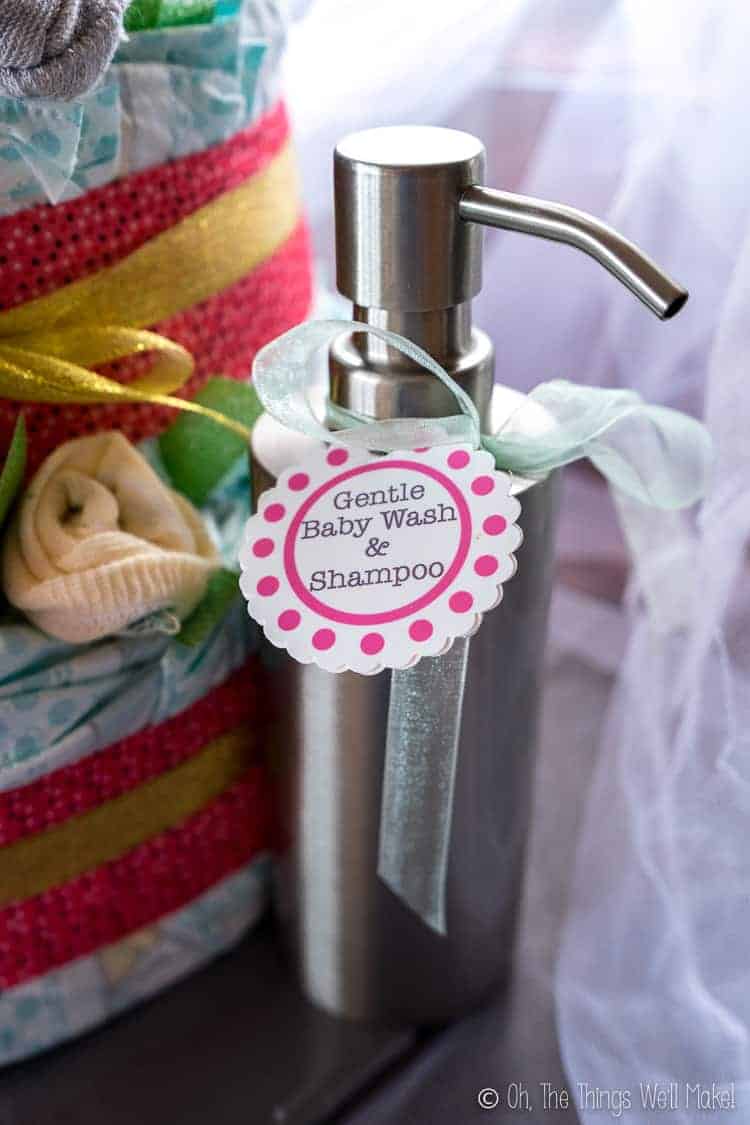
People have been asking me for a recipe for a baby wash and/or shampoo for quite some time now. So, when I was invited to a friend’s daughter’s baptism, it was the perfect time to elaborate a homemade baby wash and shampoo as part of the gift.
I did a lot of research, played a lot with different formulas, and came up with something that I really like. It has a nice, gentle fragrance without any synthetic fragrances or essential oils. It’s mild enough for a baby, but can also be used for those with sensitive skin.
Because it’s pH is in a good range for both hair and skin, it can be used as both a mild shampoo and baby wash. When you already need so many other products for the new little one, why complicate things even more with one more unnecessary product, right?
Watch how to make this homemade baby wash and shampoo.
Why make your own baby wash and shampoo?
Let’s face it: despite the fact that many products are marketed for babies, they may have harsher ingredients that aren’t necessarily the best for a baby’s soft, delicate skin.
Many people try to use soap or make homemade baby washes using soap and other ingredients because they consider soap as the most “natural” solution. Unfortunately, the high pH of soap isn’t ideal for a baby’s delicate skin either. (No, not even those said to be “baby soaps.”)
It’s tempting to just rinse a baby with water, in an attempt to protect them from unnecessary chemicals, but, on the other hand, it’s not a good idea to leave urine and feces on a baby’s delicate skin either.
So, what should we do?
How is a baby’s skin different from an adult’s?
When a baby is born, their skin has to adapt from being in a wet environment to life outside the womb. At first, the outer layer (stratum corneum) of their skin hasn’t completely formed. It’s much thinner than an adult’s skin. It also begins with a higher pH but very quickly acidifies into the same range as ours.
Because that outer layer is so thin, a baby isn’t as protected as we are from environmental factors and chemicals. Their skin doesn’t adapt as quickly as ours to changes in pH and/or other outside “attacks.” Harsh surfactants can strip their skin of oils and leave a baby more predisposed to dry skin and/or rashes.
What should you avoid in a baby wash?
Because their skin is still developing, we want to ideally use mild products that fall in a pH range that won’t irritate their delicate skin. What, then, are the ingredients that we should avoid?
Some surfactants are much harsher than others
By now, most of you have probably heard conflicting arguments about a couple of surfactants, sodium lauryl sulfate (SLS) and sodium laureth sulfate (SLES). One of these two common surfactants is used in just about every cosmetic product out there, whether it be shampoo, shower gel, or even toothpaste.
Many of you would expect me to be an SLS hater, and that’s really not the case. It’s actually not that bad of a surfactant for certain uses. It cleans well, it’s inexpensive, it gives great lather, and it makes a beautifully smooth, thick gel when easily thickened with salt. It’s normally derived from coconut oil and it’s completely biodegradable. While some people claim it’s cancer-causing, I haven’t been able to find any evidence to back up that claim. That claim, in itself, is partly based on certain other claims like that SLS can react with formaldehyde to produce “nitrosating agents.” As neither have nitrogen atoms, that would be impossible. I wrote more about my thoughts on SLS in my laundry detergent recipe post because I used in in that recipe.
While I’m not an SLS hater, I do think it is overused. It’s one of the harsher surfactants, and I prefer not to use it in personal care products. In my opinion, it should never be used in a baby wash or shampoo.

Is Castile soap safe for babies?
Many of you know me because of my soap recipes. I love making both liquid and bar soaps and have been known to use soap for just about everything. There have been a few exceptions, though. Soap may be, or at least seem like, the most natural option for cleaning, but that doesn’t mean it’s always the best solution.
The problem with soap is that it naturally has a high pH.
By now, you probably know that I don’t use soap on my hair. I shared my experiences and opinions on soap-based shampoos in both my post with a recipe for a liquid shampoo and my bar shampoo recipe. The high pH leaves my hair feeling like straw, and the vinegar rinse recommended to restore the pH after using a soap-based shampoo really doesn’t improve matters much (for me).
Our hair and skin both fall into an acidic pH range. Using soap (which is always alkaline) on our skin will raise the pH temporarily. Luckily, the change in pH is only temporary, and for most of us, that means we can use natural soap on our skin to clean it without seeing any ill effects. The pH falls back to normal within a half hour or so. Some people are more sensitive to that change, though, and may find soaps to be more drying to their delicate skin. (Others may find that soap actually helps certain skin conditions.)
When can that high pH have a negative effect?
Our hair is mostly dead, which is why it can’t recover as easily as our skin and why most of us will find that using soap on our hair will eventually damage it.
With a baby’s skin having an undeveloped outer layer, I suspect that the high pH can have more of an effect on their skin than ours too.
So, despite having defended in the past the idea that using pH balanced cleansers on our skin isn’t really necessary, knowing what I know now, I prefer to avoid using soap for a baby’s sensitive skin to err on the side of caution. While the skin of most babies should be able to recover from the temporary changes to pH, it is also more likely to take longer to recover. That means, it’s more likely to be negatively affected by the high pH.
Does that mean that I’m saying that soap isn’t safe for a baby’s skin? No, I don’t think it’s unsafe either, I’m just not convinced it’s the best solution for cleaning babies. Some people may use and be perfectly content to use soap on their baby’s skin. Others may find it too drying.
I wanted to provide another mild option for those looking for a non-soap solution!
Other common ingredients to avoid
- Parfum: Synthetic fragrances and unknown chemicals are hidden under the term “parfum.” I like to even avoid “natural fragrances” because we have no real way to know what’s in those ingredients either.
- PEGs (polyethylene glycols) are also commonly found in baby shampoos and gels. (They are usually labelled as PEG-X with the X being a number.) They are normally used as emollients or emulsifiers, but they can be contaminated with toxic impurities like ethylene oxide or 1,4-dioxane. They also change the surface tension of the skin, which means that not only could other not-so-great ingredients can get further down into the skin, but that the moisture barrier could be more compromised. I avoid using them in all cosmetics, but I think it’s even more important to avoid them in a baby product since their skin barrier is already somewhat compromised.
- Parabens are effective preservatives, but they also activate the same estrogen receptor as the natural hormone estradiol- which is why they are said to be estrogenic. While many argue that these preservatives are safe, I prefer to avoid hormone-mimicking ingredients, when possible, especially for young children. There are many safer, more natural preservatives available.
- Essential oils: While I love using essential oils to give a nice, natural fragrance to my homemade products, I decided against using them in this baby shampoo and gel. While certain EO’s, like lavender, are thought to be mild, most aren’t recommended for babies under 6 months. While they aren’t likely to cause problems, I feel safer avoiding them in baby products, when possible. I chose to use a floral water to give this product a mild, natural scent that is perfectly gentle.
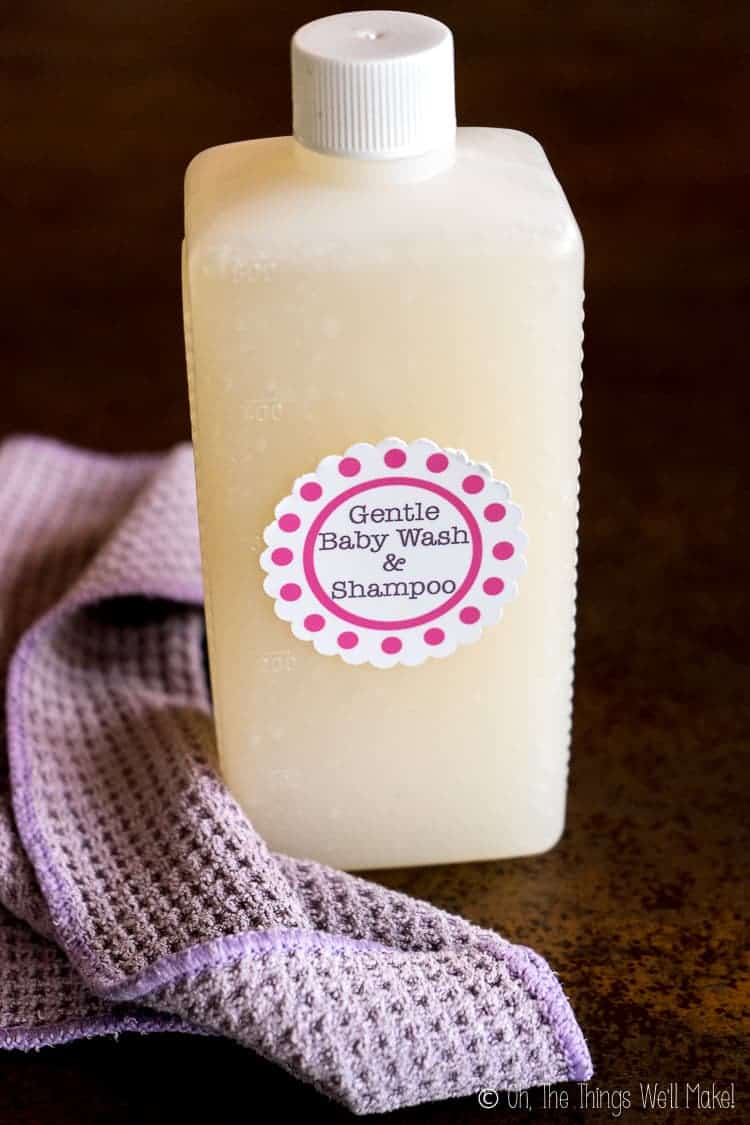
What ingredients did I use instead?
Mild surfactants
I chose to use two gentle, natural, coconut-derived surfactants, coco glucoside, and coco betaine. (For more information about them, you can read my beginner’s guide to natural surfactants.)
Coco glucoside is an ECOCERT/COSMOS approved mild surfactant from the glucoside family of nonionic surfactants. Because it is so mild and is known to be gentle on hair, it is commonly found in baby cosmetics and shampoos. It’s also used in conjunction with other surfactants to lessen possible irritation caused by them.
Coco Betaine is another ECOCERT/COSMOS approved mild surfactant. This one is amphoteric and is usually used in combination with other surfactants to help increase viscosity, boost cleansing and foam stability, all while reducing irritation of the other surfactants.
Water-Based Ingredients
Rather than use essential oils to give this homemade shampoo and gel a mild, natural fragrance, I chose to use rose water/hydrosol instead. It’s known to be a calming scent for babies, and it’s mild and not at all overbearing.
I also chose to use aloe juice as one of the water components.
You can sub out either the aloe juice or the rose water (or both) and exchange them for more distilled water instead. That will leave you with a more unscented product.
Thickener and humectant
Xanthan gum is a thickener often chosen for more natural-based products. In this case, the mild surfactants I chose can’t be thickened with salt, so I needed to look for another option. If this shampoo were too thin, it would be difficult to apply and you’d likely use too much. It’s also more likely that you’d get the shampoo in your baby’s eyes. that’s why thickening the baby wash is important.
Because xanthan gum can be tricky to dissolve, I added some glycerin to this recipe. Glycerin is a humectant that will help draw moisture to the skin. Xanthan gum can be pre-dissolved in glycerin to make it easier to incorporate into the rest of the recipe.
If you don’t want to use glycerin, you may have to do a bit more mixing to get the xanthan to be fully dissolved and distributed into the shampoo/gel. You could also substitute the glycerin for a glycerite/glycerin-based extract like chamomile extract or cucumber extract to add in other desired botanicals.
You can adjust the amount of xanthan gum up or down to personalize the viscosity to suit your taste. I’ve found that xanthan gums can vary quite a bit, too, so while 2g of one xanthan gum might make a perfect gel, a gum from a different supplier may make a way-too-thick, hard-to-use gloopy mess. To avoid using too much, start with a smaller amount and slowly add more in as needed.
(I actually made this mistake when making my video for this post. I was actually trying out a new type of xanthan gum and went right to adding in the 2g directly and ended up with a thick, gloopy mess. I had to add more water, surfactants, and preservative to make it useable again.)

Natural preservative
There are a number of natural preservatives that can be used to prevent microbial growth in this product. (I’m working on a guide to natural preservatives now, so look forward to it!) 😉
I used Sharomix 705 in my homemade baby wash, but you can use other preservatives like preservative ECO, Rokonsal, Cosgard/Geogard, Euxyl K903, etc.
Make sure to use the preservative you choose in the recommended amount for the recipe. (Most are used at around 0.5-1% of the recipe, but some, like Leucidal, may need to be used in a higher percentage by weight to be effective.)
You should also make sure that your final product is in a pH in which your preservative is effective.
pH Adjuster
To lower the pH of my homemade baby wash and shampoo, I used a few drops of lactic acid. You can use other acids, like citric acid, to lower the pH as needed. Although unlikely, if you needed to raise the pH of the gel, you can use a sodium hydroxide (NaOH) solution.
The ideal pH for this baby shampoo
There are two different lines of thinking about the ideal pH for a baby shampoo and gel. Some people believe that a baby shampoo should be pH neutral so that it is tear-free. Others believe that the baby shampoo should be formulated to be in the ideal range for their skin, despite the fact that it may be more irritating to a baby’s eyes.
What is a tear-free shampoo?
Tear-free shampoos are usually formulated to a near neutral ph (around 7.5). That’s because most eye irritation comes from a deviation of the pH of the eyes. Because a baby’s blink reflex isn’t very developed yet, they are much more likely to get the soap into their eyes. So, making a more “tear-free” product sounds like a good idea.
On the other hand, many people argue that if a baby doesn’t complain when he or she gets shampoo in their eye, you wouldn’t really know there was a problem, and wouldn’t rinse it out. Leaving it there could cause problems later on.
Also, the ideal pH for the eyes isn’t the ideal pH for skin and hair.
An ideal pH for skin and hair
While it’s true that a baby’s skin begins with a higher pH, it soon falls into the more acidic range of our skin and hair (between 4.5-6).
I decided to bring this shampoo to a pH of around 5.5 because I feel that is the ideal pH for a product meant for both skin and hair.
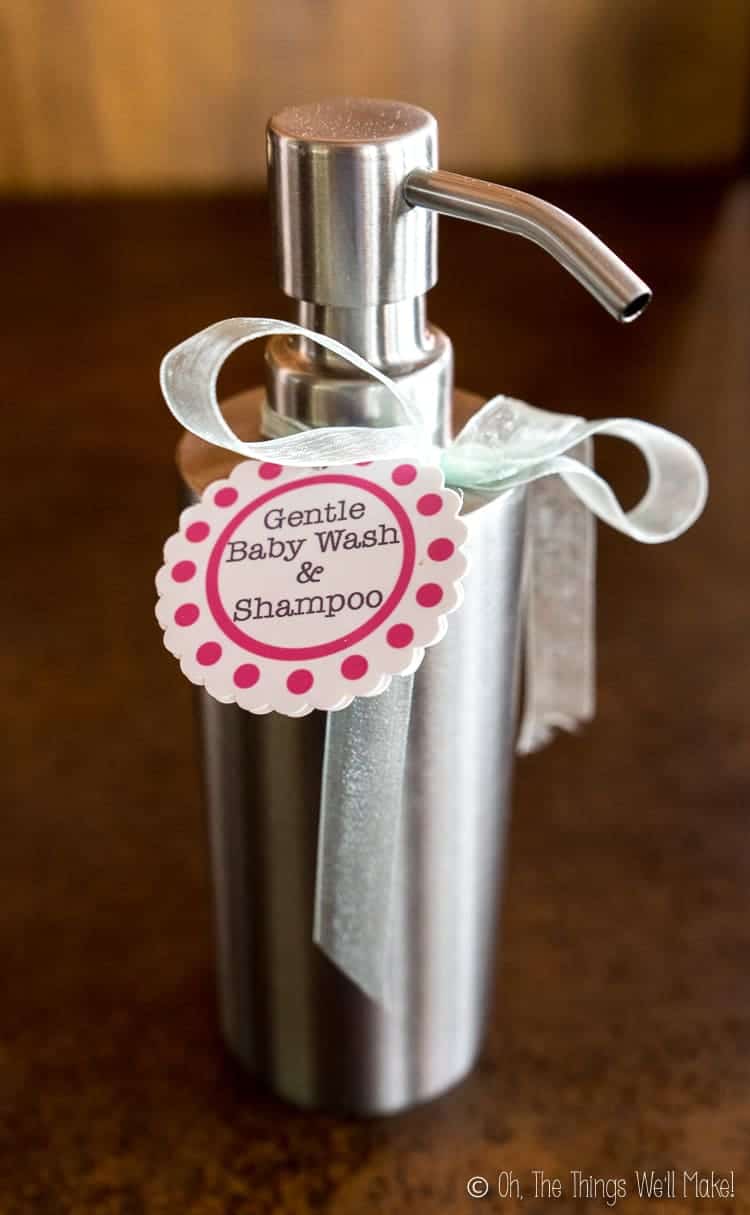
DIY Baby Wash and Shampoo
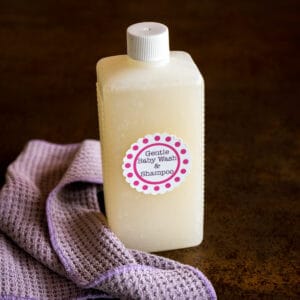
Homemade Baby Wash and Shampoo (No Soap)
Equiment
Materials
- 28 g distilled water
- 20 g rose water
- 20 g aloe juice
- 15 g coco glucoside (or decyl glucoside)
- 10 g coco betaine
- 4.25 g glycerin (or glycerin-based extract)
- 2 g xanthan gum
- .75 g Sharomix 705 (or another natural preservative in amount needed)
Instructions
- Sprinkle the xanthan gum powder over the glycerin or glycerite, and gently mix it into the glycerin as well as you can.
- Weigh out and mix the other ingredients together gently.
- Slowly begin to add in the xanthan gum and glycerin mixture, checking on the texture after each addition. Keep adding and mixing it in until you get to the desired viscosity.
- Pour the finished gel into a dispenser of choice. Ideal dispensers are those with flip tops and/or pump dispensers.
Labeling your homemade baby wash
I ended up making a couple of labels to tie onto the stainless steel dispenser that I used to gift my homemade gel. One label has the name of the product. The other one has the ingredient list. Technically, I should have written out the ingredients of the Sharomix preservative, but since this was a gift and not something for sale, I didn’t get too technical with it. I did what fit best on the label.
You’re free to use my labels. I printed them out together onto a 4×6 inch (10x15cm) card. I then cut out the circles with a 2-inch craft punch and glued them together. I punched a hole in the top and tied it to the dispenser. You could also glue the labels to the bottle as I did with the plastic bottle shown above.
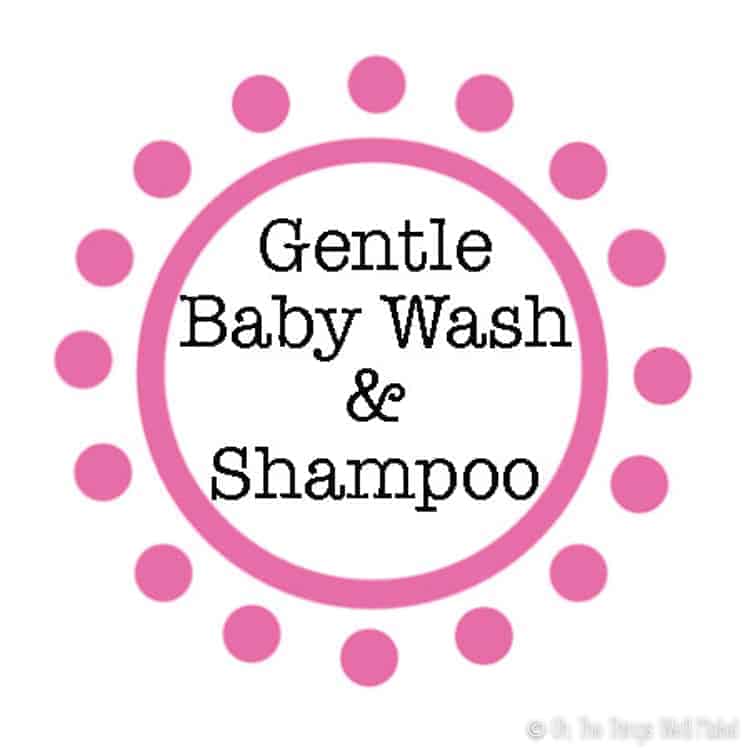
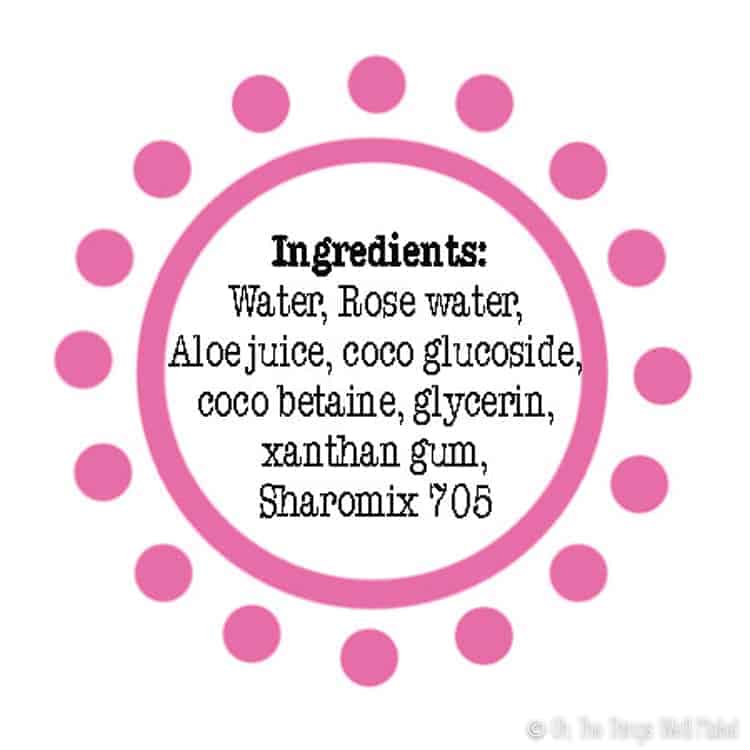
 Español
Español
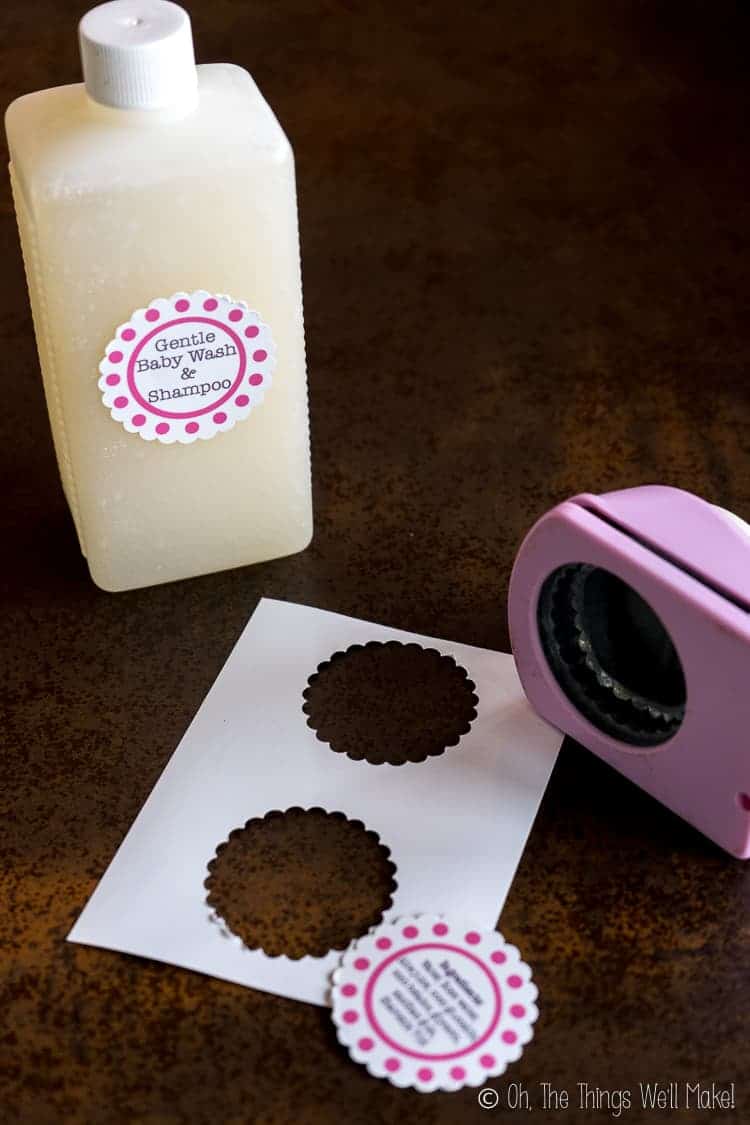
 Beginner-Friendly Ladybug Mandala Rock Painting Tutorial
Beginner-Friendly Ladybug Mandala Rock Painting Tutorial
Teresa Evans
Greetings I live in the US and I want to make the baby wash for my granddaughter however Ihave not been able to find Sharonmix 705. Do you have any other suggestions for a similar preservative?
Thank you
Tracy Ariza, DDS
Hi Teresa,
I have a whole post dedicated to natural preservatives that may help give you suggestions. Most of the preservatives listed there should be fine in this recipe. You may consider avoiding any of the preservatives with salicylic acid as they aren’t usually recommended for leave-on products for babies. While this isn’t a “leave on” product (it’s a rinse off one), you can use this wash for homemade baby wipes, in which case you would leave a small amount on the skin. I always like to err on the side of caution, so… 😉
Teresa Evans
Thank You?
Shawn
Is this recipe suitable for a foam pump?
Tracy Ariza
Hello Shawn,
Yes, of course!
If using in a foam pump, there’s really no reason to thicken it with the xanthan gum. So, the recipe is even easier that way!
Bles
Hi Tracy,
Any chance you’ll be making a baby lotion? Would you suggest maybe using your lotion recipe for babies?
Thanks
Bles
Tracy Ariza
Hi Bles,
Yes, you can definitely use the tips for the general lotion for making one for babies.
I’d suggest keeping in mind some of these same principals- no need for essential oils, etc.-
That’s a great idea, though. I can definitely work on a baby lotion recipe! ?
Bles
Thanks Tracy. I look forward to it! I use your lotion recipe and it’s amazing. I do add a bit of fragrance to it though, because I like a bit of scent on my lotions. That is pretty much the only synthetic ingredient I use for my home products.
Tracy Ariza
Hi Bles,
Thank you! Yes, I understand. We all need to decide on our priorities. I’m definitely not always all-natural either. I just do my best to reduce my toxic load, especially when the more natural alternatives don’t bother me. That’s all we can really do. ?
Chris
I’m confused. I have been searching everywhere to find Coco Betaine. I finally clicked the link on this page and see that it’s linking to Cocamidopropyl Betaine. However, according to what I’m finding these two are not interchangable and are very different (according to https://realizebeauty.wordpress.com/2015/10/18/yes-coco-betaine-and-cocamidopropyl-betaine-are-different-chemicals/) . Cocamidopropyl Betaine seems to be synthetic, while Coco Betaine is not. Which one should be used in this recipe?
Tracy Ariza
Hi Chris,
Yes, they are different, but almost identical. From what I understand the main difference is the one you stated, but otherwise they should act the same.
They should still be interchangeable.
I have looked and looked for more information on the subject because in one of the classes I took on natural surfactants, they used them interchangeably and said that Coco Betaine was another name for Cocamidopropyl Betaine. I, like you, have found information that says otherwise, but not enough to make me think they wouldn’t be interchangeable.
I buy the Coco Betaine here in Spain, so I’m not sure where to find it in other countries. I do my best to look for something people can use to make the recipes. Links to Amazon get automatically switched to something similar depending on the country one is searching from. While I do my best to try to look for good alternatives for people, you may not be seeing the product I chose, depending on your country.
I hope that makes sense.
In any case, you should be able to make the recipe with either. It should still be quite mild. I do prefer Coco Betaine (from what I’ve read about both), but if you can’t find it, the other is an acceptable alternative.
Mansoor
Exelent job
Tracy Ariza, DDS
Thank you!
Ruzanna A.R
Thanks for the reply!
Appreciate you taking the time!
I do have curly hair so the link you provided is awesome and will give me clues.
I honestly take a 2 min shower thus with curly tangled hair and 3 little kids, the convenience of having a shampoo and conditioner in one is logical for me.
In that batch i heated the corn starch separately with the water first to thicken… And well the downside is that it isnt emulsified well..separation does occur…
I noticed when making these things they tend to improve slightly a few days later… Wondering if it takes some time for the ingredients to properly mix…
Anyways.. I’m looking fwd to attempting your other recipe.. thanks and hope you continue to share!
Tracy Ariza
Hi, you’re welcome!
Yes, it’s all about experimentation.
I understand you wanting to speed things up. I find that if I’m taking care of my hair, though, that it doesn’t need as much attention. I normally only shampoo once a week. I may wash it with only conditioner during the week. In the end, using a shampoo really doesn’t take a lot of time out of my life. ?
And, yes, I’ll be sharing more recipes soon.
I’ve been working hard to fix up older posts lately. I really want to get my blog in tip-top shape and then will put more focus into new things. I will be adding a few new posts along the way, though.
Kikis Fraga
Hola amiga!!! Me encantaron todas las recetas de tu pagina, muchas gracias tambien por responder mis dudas en tu canal de Youtube… Yo he empezado a cambiar en los usos de productos para la ? por su bienestar de la salud. Admito que de las mamas practicas que compraba hasta la pastilla tomada para eliminar piojos , claro que ahora busco alternativas mas saludables sin dañar la salud de mis hijas. Me encanto el sprayde los piojos lo voy hacer no tengo problema con el udo de los aceites yaque mis nenas son universitarias..jeje pero una de mis hijas tiene el cabello demasiafo extra rizado y atrae como iman estos bichitos que abundan en todas partes. Quisiera saber di me puedes recomendar libros de quimica cosmetica natural que me ayuden a entender las propiedades de los aceites, los emulsantes que mencionas o conservantes…etc etc terminos o conceptos que apenas voy comprendiendo… Algun libro o documentacion que me recomiendas o me facilites porfavor… Gracias por todo!! Bendiciones
Tracy Ariza
Hola Kikis,
Perdona la tardanza en responder. Es que realmente no tengo ni idea. Pensaba buscar un poco a ver lo que hay.
El único libro que tengo sobre los aceites que hay en español es esta:
Me lo recomendó una chica de una tienda natural. Su marido lo usaba y él era naturópata.
Tengo otro libro en inglés.
También he hecho algún cursillo por internet.
Ruzanna
Hi Tracy!
I’ve found your website, and been enjoying reading and absorbing the information in it!
I love seeing how quite simple most of your recipes are, and watching the videos of how clean quick and easy you make them!
I’ve attempted to make this Baby wash and shampoo, with a bit of tweaks since I was making it for my toddlers and myself, and did not have a few ingredients at hand.
Basically I replaced the Aloe and Rose with distilled water
I used Citric Acid as a PH balancer
Low PH Preservative (Sodium Benzoate (and) Potassium Sorbate) that is what I had with me
And I used Corn Starch as a thickiner (I didn’t have Xantham Gum)
I tried shampoing my head with it, and the hair seemed to have tangled a lot more, and become coarse.
I have been trying to find an easy solution to a conditioning shampoo!
Do you have any idea what went wrong? or would you have a suggestion as to what I can use to make it conditioning and shampoo in one?
Thank you for taking the time to read this! I do hope you can help
Ruzanna A.R
Also forgot to mention I used essential oils – since I was making it not for babies 🙂
Tracy Ariza
Hi Ruzanna,
This should be very gentle, so I’m not sure why it seemed to tangle your hair. The only thing that I think would make things a bit weird- is the corn starch. It doesn’t thicken in the same way- and needs heat to thicken. It may also make the shampoo more prone to microbial growth.
That said, I always use some sort of conditioner afterward. Sometimes I only wash my hair with conditioner as my hair is also quite fine and prone to damage.
Conditioning agents are normally cationic. There are options to play with, but I haven’t been very successful in making anything that could be considered a conditioning shampoo really (I have been working on a cleansing conditioner, though). There are cationic gums- a cationic xanthan, I think- but I haven’t been able to find it. There are cationic emulsifiers, and then there are some other conditioning agents that may work well in a shampoo. (You can find some here: https://www.naturallycurly.com/curlreading/curl-products/cetrimonium-chloride-5-more-surfactants-curly-hair-actually-loves-si )
I find it easier to just make shampoo and conditioner separately, though.
Jennie
I would like to make this for my body wash, but am allergic to aloe and rose. Can I sub something for them (an oil, or distilled water)?
Tracy Ariza
Hi Jennie,
Yes, of course!
I chose those as they tend to be gentle and the rose adds a subtle scent I love.
You can either switch them out for more distilled water and leave your gel unscented, or you can switch them out for a floral water of your choice. You could also switch them for more water and then add a couple of drops of an essential oil of your choice to add a bit of scent.
Saratu
This is so wonderful and it’s quite generous of you.
Tracy Ariza
Thank you, Saratu. 🙂
Anne Kennette
Hi. Thank you for this recipe. Is this tear-free?
Tracy Ariza, DDS
Hi Anne,
As I mentioned in the post, to make a soap tear-free, you’d have to adjust the pH to 7. Some people are against doing that, though.
It really depends on your priorities for the shampoo.
You can adjust the pH up using something like a lye solution (be careful is using lye), or arginine or another pH adjuster.
Gabriela
hola me encanto todo tus conocimientos y gracias por compartir.
Tracy Ariza
Gracias, Gabriela!